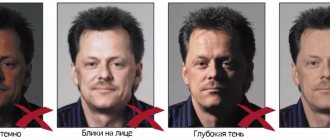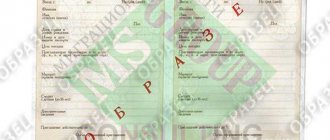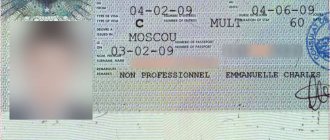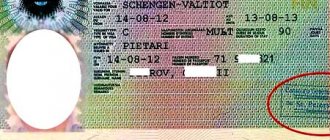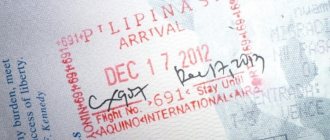What does a visa look like?
The Schengen visa is a relatively small colored sticker pasted onto the first of the free pages of the passport. To understand the definition of a Schengen visa, it is not necessary to know a foreign language at a fluent level. All codes and meanings given are easy to understand. In addition, the visa form is duplicated in French and the official language of the country to whose embassy you submitted documents.
What is needed to obtain a Schengen visa? In addition to the application form, the citizen is required to provide the embassy with a package of documents, including civil and foreign passports, a certificate of employment, medical insurance, justification for the purpose of the trip and two photographs 35 by 45 mm. Also, before submitting an application, you must pay a visa fee of 35 euros and a service fee - from 17 to 22 euros.
What information is included on the visa?
Having received permission to enter the European Union, the first thing you should pay attention to is the upper left corner of the sticker, where the Schengen visa number indicates the country of issue of the document. You will see a three-letter combination that border control officers use to determine the country of “first entry.” A complete breakdown of the values indicated in the text of the visa document is as follows.
- Valid for – territory of action. If we are talking about a Schengen visa obtained at the Spanish embassy, then the first line will indicate Estados Schengen. If the permit was issued in any other country, the inscription will be in the state language. On national visas, unlike Schengen ones, it will not be indicated “Schengen Union”, but a three-letter designation of the country to which the document is valid.
- From (beginning)… Until (end) – the validity period of the document.
- Type of visa – type or category. If the entry permit is single, then one Latin letter is placed, indicating the type of visa document. For multivisas, MULT is indicated.
- Number of entries – number of entries.
- Duration of stay – the allowed number of days of stay in the Schengen area.
- Issued in – city of issue.
- ON – date of issue.
- Number of passport – international passport number.
- Surname, name – surname and first name.
- Remarks – additional information for border control officers.
Decoding the Schengen visa
When the registration process is over, and the coveted permit is pasted into the passport, you should understand its designations. It is worth taking the time to decipher the visa in order not to violate the rules for using the issued pass and not to get into an unpleasant situation abroad.
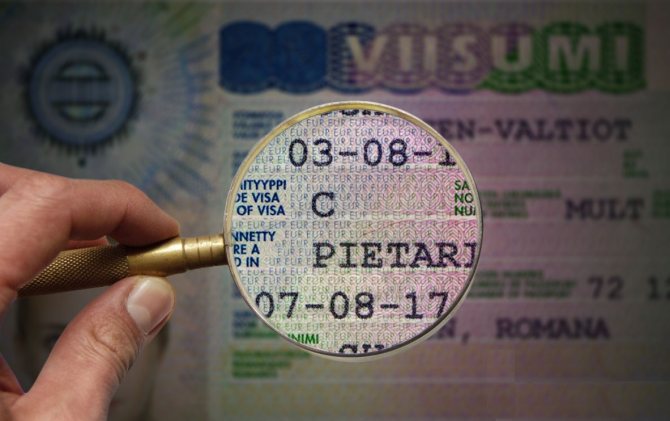
You need to understand what the numbers and codes mean, where to look for expiration dates, and how many visits are allowed. Decoding the Schengen visa in your passport will help avoid possible misunderstandings.
To be sure of the rights that a Schengen visa provides, the first thing you should pay attention to is the fields with filled data.
Remember
The dates entered in fields #3 and #4 do not mean that you can stay in the Schengen area for that particular time. The period of stay of one visit is indicated in column number 7 “Duration of stay”. We will consider this visiting rule further below.
5. Type of visa. Visa type, this field contains a letter that has the following meaning. There are 4 types in total:
- A (airport transit visa);
- B (transit);
- C (“visitor” visa);
- D (long term).
Most often, people apply for and receive a type C visa, which includes tourist, cultural, and sports trips.
6. Number of entries. Number of entries. Once upon a time I did not read this field, and only figured it out after the validity period had expired.
This visa gives you a corridor of three months, with the possibility of making two trips, but I only made one entry into Europe.
There may be designations in the passport:
- MULT - possibility of multiple visits;
- 01 - single entry;
- 02 - double entry.
7. Duration of stay. The number of days of stay during one period of entry, specified in the From and Until . It is always indicated in two digits, for example, in this case 15, but if the allowed number of days is less than 10, then zero comes first.
If the visa is issued as a MULT or double entry visa with a corridor for a year, and the number of days of stay is indicated as 30, 45, 60, 90 or another number of days, this means that each time you re-enter the Schengen area, the number of days is added up . If the number of days is over 90, then nothing is indicated in this field.
For example, you were issued a multiple visa valid from 01/01/2016 to 12/31/16 with a number of days of stay of 45.
From: 01/01/2016 Until: 12/31/16 Number of entries: MULT Duration of stay: 45
This means that within 365 days you can enter the Schengen countries more than twice, but the total number of days of stay should not exceed 45. For example, a trip in March for 10 days, a trip in August for 20 days, and a trip to October for 15 days, a total of 45 days of stay. Further, the visa is considered valid, but closed, since you have completed the required number of days.
8. Issued in. The city or authority where the visa was issued.
9. On. The date of issue of the document, not to be confused with the beginning of the action. In our example, the validity of the visa began 4 days after the date of issue.
10. Number of passport. Passport ID.
11. Surname, Name. Last name and first name.
12. Remarks. This field indicates the purpose of the visit. Each country writes differently. In this case, the purpose of the Hungarian visa is “Culture”. The Polish consulate usually writes CELWYDANIA: 01, which means a trip for the purpose of tourism.
13. Encoding. It is read at the border through a special machine by the border service.
The following data is encoded in it:
- The first letter V stands for visa;
- The second letter A, B, C, D - indicates the type of visa;
- This is followed by the designation of the country that issued the visa - HUN, POL, D, ESP and so on;
- This is followed by the surname and first name;
- The numbers in the second line are the visa sticker number;
- Next, the citizenship of the applicant;
- Date of Birth;
- Check digit;
- Floor;
- Number of entries;
- Effective start date.
All the data that is specified in the visa above is entered here, only the designations are in abbreviated form, intended for decoding by a computer.
What is the passport number?
Decoding the Schengen visa in the passport
On any visa, the names of the points are written in three languages: English, French and Russian (or the country where the visa was issued).
- Valid For – a point indicating the territory where the visa is valid. Etados Shengen – the permit is valid in all Schengen countries. This inscription is the most popular, but stamps are sometimes limited by state. Under this condition, it is permitted to travel to the countries indicated, for example:
- A – Austria;
- B – Belgium;
- CH – Switzerland;
- CZE – Czech Republic;
- D – Germany;
- DK – Denmark;
- E – Spain;
- EST – Estonia;
- F – France;
- FIN – Finland;
- GR – Greece;
- H – Hungary;
- I – Italy;
- IS – Iceland;
- L – Luxembourg;
- LT – Lithuania;
- LVA – Latvia;
- M – Malta;
- N – Norway;
- NL – Netherlands;
- P – Portugal;
- PL – Poland;
- S – Sweden;
- SK – Slovakia;
- SVN – Slovenia.
- Another travel method is indicated by “Etados Shengen - country code or countries”, for example, “Etados Shengen – S” means that you can visit all Schengen countries except Sweden.
- From – date from which you can visit Schengen.
- Until – visa expiration date.
- Tupe of visa – indicates the type of visa:
- A – for transit through the airport;
- B – for crossing the borders of several countries for up to 5 days;
- C – short-term, allowing you to stay in Schengen territory for no more than 90 days per six months;
- D – long-term, giving the opportunity to travel, work or study in the Schengen countries for 3 or more months in a six-month period.
- Number of Entries – number of entries. There may be several options:
- “Mult” – unlimited number of trips;
- “1” – one departure;
- “2” – two trips to the Schengen area.
- Duration of Stay – the number of days spent in Schengen territory.
- Is Sued in – the city that issued the visa.
- On – visa issue date.
- Number of Passport – your passport number.
- Surname, name – surname, first name.
- Remarks – note.
- Photo area. The head should take up 70-80% of the entire photo.
- Zone for automated data reading – consists of 2 lines of 36 characters.
2nd line by signs.
The meaning of deadlines
At first glance, the specified validity period is not subject to any ambiguous interpretation.
However, practice shows that some citizens mistakenly attribute the validity of a visa to the time of stay in the European Union. Such an inaccuracy can lead to a person overstaying the visa issued to him and upon leaving for Russia, he will automatically receive a ban on entry into Europe for several years to come - for violating migration laws. The validity period of a visa is the period during which it can be used. As a rule, for ordinary tourist visas of category C1/C2 it is 180 days. In this case, the maximum period of stay of a citizen in Schengen territory on such a visa will be, respectively, from 30 to 90 days.
Which state issued the document?
The holder of a foreign passport must know what the three-letter combination indicated in the Schengen entry permit number means. This will eliminate possible mistakes when choosing the country of “first entry”. For example, the combination LTU means Lithuanian visa. You can find out which country issued you an entry permit without even resorting to decryption. If the visa was issued by the Finnish Embassy, the combination will look like FIN. If you received permission from the Spanish embassy, then ESP will be indicated on the visa. Similar combinations are assigned to other states.
Basic provisions
Having a certificate of entry into the Schengen countries gives the holder the right to move freely within their territory. You can stay in these countries for no more than 3 months every six months. Resettlement rules should not be violated, as this may result in unpleasant issues for the tourist in the future or lead to a refusal to issue permission to enter a foreign country.
It must be remembered that a Schengen visa is requested in the country in which the traveler intends to spend more time. If the time is not specified or is divided into an equal period of time, then the application is made in the country whose border will be crossed first.
Read about how to get Schengen yourself by following the link.
How to find out your visa type
To easily identify the types of Schengen visa, you need to remember several letter values.
- A – airport transit visa, which allows a citizen to stay in the international area of the terminal for up to 72 hours. Typically, an airport visa is issued to those tourists who plan to make a transfer.
- C (transit) – a transit visa that replaced category B, which is no longer issued. This type of entry permit allows you to stay in Schengen territory for up to 5 days for the purpose of transit to a third country.
- C – visa for a private trip for the purposes of tourism, business, treatment. This category does not allow for employment or study opportunities.
- D – national visa. Issued for work or study. Valid only in the country of issue.
- MULT – multiple or multiple entry visa. It has a longer validity period (1,2, 5 or 10 years) and an unlimited number of visits to the Schengen area. The restriction applies only according to the 90/180 principle - the maximum number of days spent in the European Union cannot be more than 90 within six months.
Features of a multiple visa
What does a Schengen multiple visa look like? It does not have any characteristic differences from a one-time permit, with the exception of the Number of entries column. It will contain the MULT code, the presence of which indicates that there are no restrictions on the number of trips within the validity period.
Foreign embassies take special care when issuing multiple-entry Schengen visas. Therefore, if you want to find out how to get a multiple visa, then first you will need to have at least several trips to the European Union on single-entry visas. If during your stay in the Schengen zone you do not have any violations of local migration or administrative legislation, and the purpose of your trips to Europe is justified, then there is every chance that your application for a multiple visa will be approved.
Category C visa or short-term visa
A category C visa or short-term visa is an individual single-entry, double-entry or multiple-entry visa that gives a foreigner the opportunity, respectively, one, two or an unlimited number of times during the time specified in the visa to cross in transit or enter and be planned to stay in the territory of the countries participating in the Schengen Agreement.
A category C visa can be a “single visa”, valid on the territory of all countries party to the Schengen Treaty, or a “visa with limited territorial validity” (ITD visa), valid on the territory of one or more, but not all countries party to the Schengen Treaty.
The maximum period of stay on a short-term visa in the Republic of Latvia and other other countries participating in the Schengen Agreement cannot exceed 90 days within six months, counting from the first day of entry.
The decision to issue a category C visa or to refuse a visa is made in accordance with the Visa Code.
What is encrypted at the bottom of the document
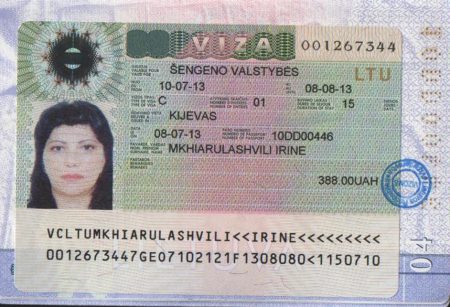
Many tourists are interested in what information is located at the bottom of the Schengen visa decoding - where the code of numbers and letters is located, the content of which seems difficult to determine. However, if you have the necessary information, it is not difficult to decipher the meaning of this.
Indeed, the coding at the bottom of the visa is designed for computer scanning. The information is read by a special scanner, which allows you to instantly enter information about the owner of the international passport into the database. The encoding is deciphered as follows:
- the first letter is the name of the document;
- the second letter is the visa type or category;
- a three-letter combination indicating the country of issue;
- last name and first name of the passport holder;
- visa number;
- citizenship of the passport holder;
- Date of Birth;
- check digit;
- floor;
- permissible number of entries;
- validity.
The information provided here will allow anyone to know how to read a Schengen visa correctly. Accordingly, the likelihood that a tourist will overstay it due to discrepancies in the validity period or territory of the document will be reduced.
What information does the visa contain and what do the marks on it mean?
Check that the following items are present and filled out correctly:
- passport series and number;
- first and last name in Latin letters;
- validity period of the printed document;
- the exact number of days of stay in the country;
- clear consulate stamp.
Deadlines
If a visa opened in a foreign passport is valid for more than six months, then in this case the document will indicate the number of days during which you can live in the country every six months. For example, if a visa stamp is issued for a year, and in the column “number of days of stay” it is written “45”, then it should be taken into account that you cannot stay in the Schengen zone for longer than the specified period during the first and second half of the year.
What country was it issued by?
The visa issuing country is selected as follows. To obtain a visa sticker, apply to the consulate of the particular state for which the trip is being organized. If you plan to visit several countries, the visa stamp must be issued by the consulate of the state where the traveler plans to stay longer.
Where to look for your visa number
If you need to look at the Schengen visa number of the countries participating in the agreement, then finding it is easy: it is 9 characters in the upper right corner. Usually there are letters and numbers written there. But letters are not always found in the character set.

